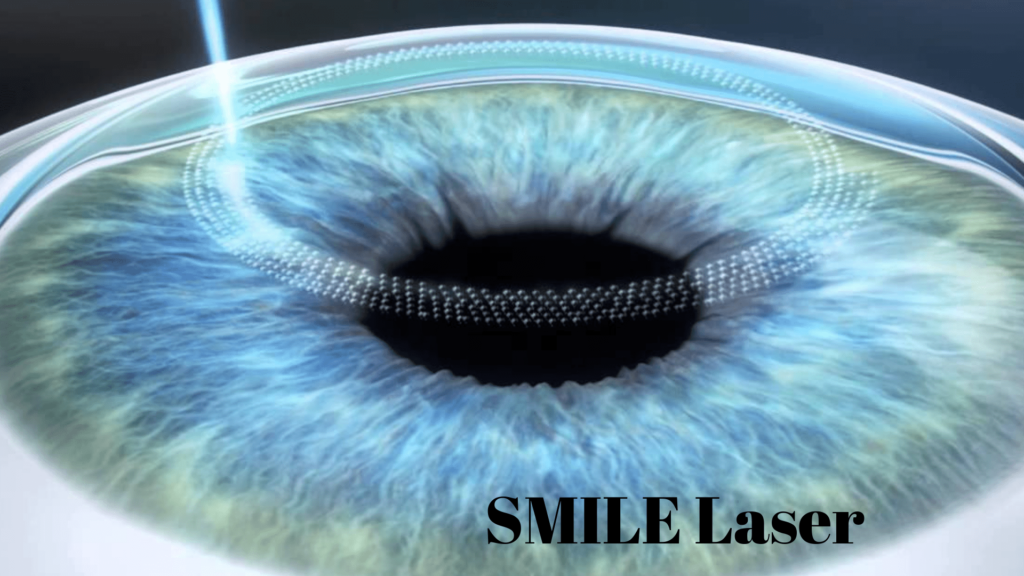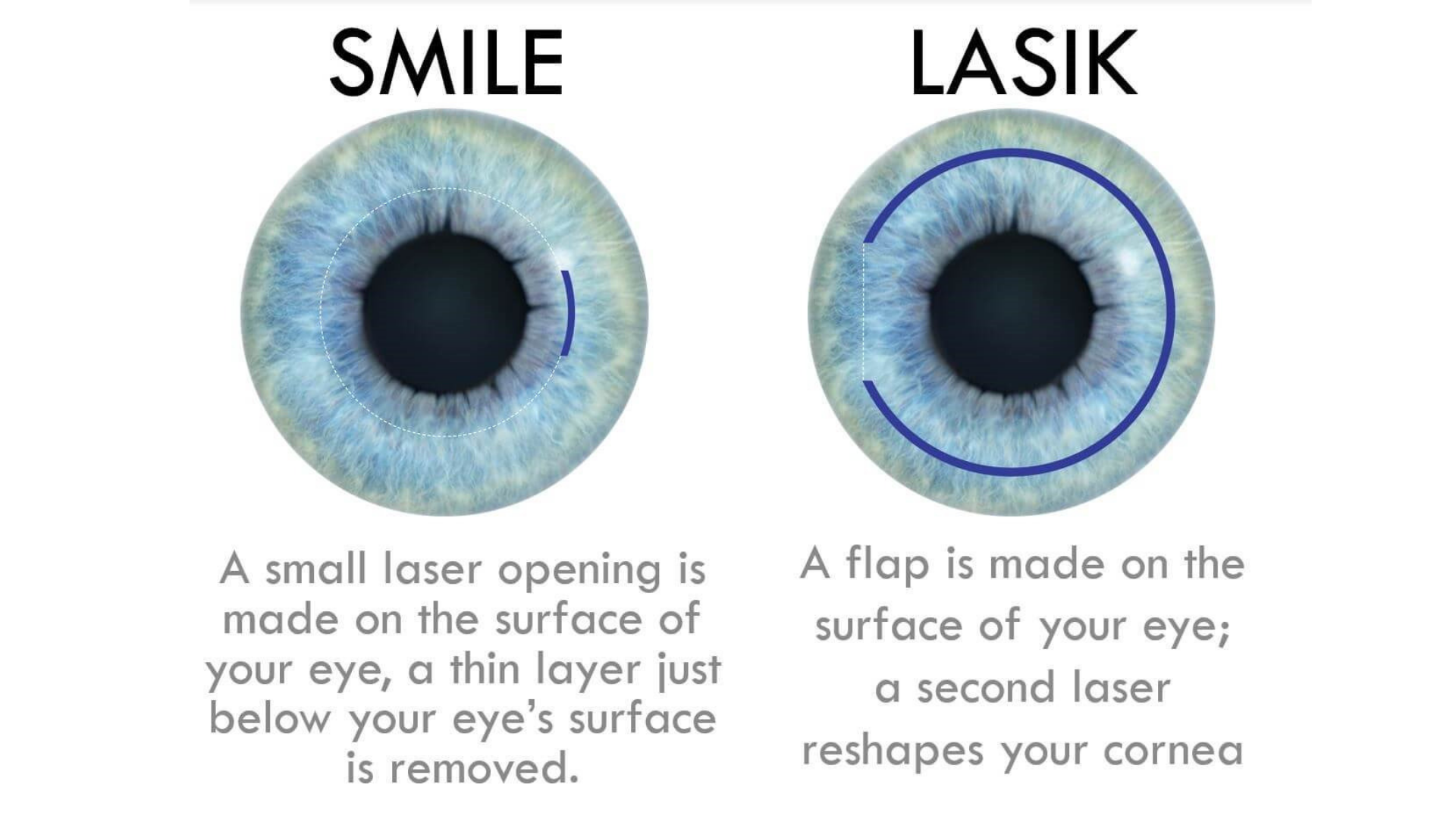In addition to LASIK, to correct nearsightedness you now may have the option of a new laser procedure called SMILE Laser surgery. SMILE (small incision lenticule extraction) is a laser vision correction surgery that is similar to LASIK. Since the introduction and broad availability of LASIK surgery, improvements have constantly been made. In 2012, a procedure called Small Incision Lenticule Extraction, or SMILE, was launched. This procedure is a type of refractive surgery that utilizes Femtosecond Laser. Instead of cutting a thin flap on the cornea, SMILE cuts and excludes a thin corneal lenticule. And then removes it through a tiny incision ranging from 2 to 4 millimeters in a minimally invasive procedure (Blade-free Vision Correction).
Contents
What is SMILE Laser Surgery?
SMILE stands for Small Incision Lenticule Extraction.
SMILE laser eye surgery is performed using a VisuMax femtosecond laser, which is the established technology of Carl Zeiss Meditec.
In the SMILE procedure, the surgeon handles a femtosecond laser to form a small, lens-shaped bit of tissue (lenticule) within the cornea. Then, with the same laser, a small arc-shaped incision is performed on the surface of the cornea, and the surgeon extracts the lenticule through this incision and dismisses it.
With the small lenticule removed, the shape of the cornea is altered, improving nearsightedness. The corneal incision improves within a few days without stitches, and sharper vision occurs very soon.
SMILE laser eye surgery can improve up to -10.00 diopters (D) of nearsightedness. Applicants must be at least 22 years old, have no more than -0.50 D of astigmatism. And their eyeglass prescription must be constant for at least 12 months.
Benefits And Advantages Of SMILE Laser Surgery
Research is showing SMILE produces virtually the same visual acuity as LASIK for the correction of nearsightedness, without the need to create a LASIK-style corneal flap.
In one study of 328 people who underwent the SMILE procedure, all but one had uncorrected visual acuity (UCVA) of 20/40 or better after surgery, and 88 percent had UCVA of 20/20 or better.
Also, it seems there may be less risk of dry eye symptoms after SMILE, compared with LASIK. There may be several reasons for this, including that because SMILE takes place within the cornea without a large corneal flap, fewer corneal nerves are affected by the procedure.
The very small SMILE incision may also enable the cornea to have more biomechanical stability after SMILE, compared with its ability to maintain shape (especially the following trauma) after LASIK.
Finally, for the correction of high amounts of nearsightedness, with LASIK there’s a greater risk of needing an enhancement procedure to attain the clarity of vision desired without glasses. It appears there is less risk of needing an additional procedure after SMILE for the correction of myopia. It is possibly because less dehydration of the cornea occurs during the SMILE procedure.
Limitations Of SMILE Laser Surgery
Are there any downsides to SMILE surgery when compared with LASIK or PRK?
For starters, SMILE can only correct nearsightedness, whereas LASIK and PRK can also correct significant amounts of farsightedness and astigmatism. Also, LASIK and PRK can handle higher-order aberrations (HOAs) that can affect night vision, whereas SMILE cannot. SMILE might improve HOAs to some extent.
And if you have residual refractive error after a SMILE procedure and require additional vision correction. Typically PRK would be the preferred enhancement procedure for best results.
Finally, as with any newer vision correction surgery, it may be necessary for a surgeon to perform a significant number of SMILE procedures before he or she masters the surgical techniques required for optimum outcomes and minimal risks. Keep this in mind when considering SMILE (versus LASIK or other vision correction procedures). And while discussing the procedure with your refractive surgeon.
Complications Of SMILE Laser Surgery
Complications appearing during the SMILE procedure have been reported very rarely, supporting the reported safety and predictability of the procedure. Studies using SMILE found epithelial abrasions, small tears at the incision, and perforated caps in few events. However, none of these patients had late visual symptoms. The loss of suction during the femtosecond laser portion of the procedure is one of the main complications with SMILE. And it appears to be a difficult topic to define care that applies to most or all cases. While recorded to be very infrequent, one study revealed the majority of cases in which suction loss occurred were capable to be reapplied in the same setting.
Is SMILE good?
If you are nearsighted and match the criteria, you might be a good candidate for SMILE laser vision correction. The next step is to have a comprehensive eye checkup with your eye doctor. And a consultation with a refractive surgeon.
Conclusions
The SMILE procedure, while it is in its initial stages, resembles to be a hopeful choice to LASIK. Given its flapless procedure and outcomes that seem to be similar to LASIK, it may offer the same correctional abilities with the possible benefits of the faster recovery of post-op dry eye, faster reinnervation of corneal nerves, and biomechanical benefits.
For getting a service for the eye issues we have best eye hospital Delhi and the best doctor. For receiving them log into our website EyeMantra. Our experts will take give all possible treatments to make your vision clear and you have a happy and peaceful life. We deliver various services like Computer Vision Correction, Paediatric Ophthalmologist, Specs Removal which can help in having good viewing power.
For any service call us at +91-8851044355. You can also mail at eyemantra1@gmail.com.
Have a happy service experience with us!
You may also check:
Do’s and Dont’s for protecting your eyes while playing holi



